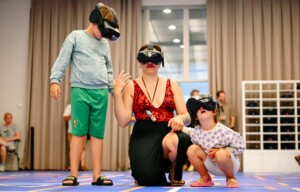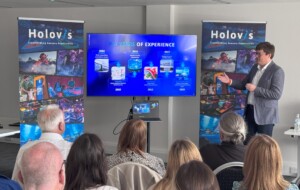From AV to AC
Commiserating about the heat and humidity on the way to dinner Wednesday evening, we were treated to a description of such a device by our friend and colleague Fred Ampel of Technology Visions, with whom we’ve teamed up the past few years to create the Immersive Audio Experience booth at InfoComm (no IAE this year, but the team will be back soon with its successor). (See: Sound Out the Possibilities in the Immersive Audio Experience at InfoComm 08) The “Personal AC Bubble, ” as Fred and some buddies imagined it earlier that day, would be a freon-charged “cone of cooling” made of electrically reactive plastic that would enclose most of a person but stop short of the feet. It would have a zipper closure and secure around your ankles with velcro. Its thermally reactive superconductor would enable it to immediately lower the air temperature within it by 20 degrees (Fahrenheit), with a simple push of the “panic cool” button.
Birth of the cool?
It would be nice if the new products on the floor were as inventive as Fred’s imaginary personal cooling device but that’s fantasy vs reality. After teaching the first half of the day, we began the tour, already feeling somewhat jaded because earlier reports lacked buzz. Perhaps the most exciting thing we discovered (so far) in the world of black boxes was the expansion of Extron’s control systems, making the company a true number three in the arena of control, positioned with AMX and Crestron. Another big three for the books.
At the AMX booth, our first scheduled meeting of the day, while looking at their version of a digital signage videowall, we saw Robert Simpson of Electrosonic stop and view the wall – a dramatic coincidence in view of his company’s pioneering and influential efforts in video wall displays early in the game some 15 years ago – an observation lost on most of those around us. From there we trekked to the end of the hall and began working our way through, stopping at the Wolfvision booth, where we were pleased to see their continual improvement of an already excellent line of document cameras. One of the other cool things we saw today was the display at the booth of Cool Components, which makes excellent housings and fixtures to prevent heat buildup in equipment enclosures – great for racks and teaching lecterns.
Ergonomics of visualization
Speaking of teaching lecterns, Thorburn Associates associate principal Jim Horn is the kind of teacher who encourages student participation and as a result his session, “Building the Perfect Teaching Station, ” enables people in the university field to compare notes and captures a snapshot of market needs and conditions. Two of the issues that emerged when Jim taught the class Thursday morning:
1. Shrinkage, aka disappearing inventory. As teaching stations become more sophisticated, it is increasingly important to secure their components. Wireless microphones and remotes are particularly vulnerable to wandering off unintentionally with absent-minded professors. Methods used to counter this tendency to vanish include requiring users to check them in and out, and locating a charging station in the podium. To help keep track of projectors and DVD players, which tend to mysteriously disappear, especially around the Super Bowl or other major televised events, some schools use a screamer alarm linked to a sensor and automatic email notification.
2. Although the use of AV in the classroom is widespread, relatively few people know the basic formulas for calculating optimal sightlines and distances relative to image size: the four-six-eight rule originally presented by the late Dr. Kim Milliken (right), pioneer designer of projection screens for visual displays. A great friend and educator, Kim received InfoComm’s Lifetime Achievement Award in 2002. It works like this: image height multiplied by six equals the maximum distance to the furthest viewer. (The ratio is dictated by image height as opposed to width because it relates to text size.) In situations where the screen is destined for use as a movie or television display, multiply by eight. In situations with complex visuals such as maps or X-rays, multiply by four. The ergonomics of visualization also call for the bottom of the image to be approximately 1 meter above the floor.
We’re dedicating this column to Kim Milliken, whom we fondly remember and miss. In the spirit of Kim’s exemplary optimistic outlook on life and the industry, and having covered only about 20% of the InfoComm floor so far, we’re hopeful that our quest for inspiring and inspired new products will yet be a rewarding one. Stay tuned for our Friday report and the rest of the story.
Audiovisual and Acoustics Engineering: Steve Thorburn Reports from InfoComm
Technology for Entertainment, Education and Business: Steve Thorburn Reports from InfoComm 09
Themed Design: Seven Steps of Tech Design Success
Themed Design: Modern Building Design Demands Partnership between Tech Designers and Architects








